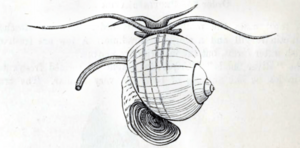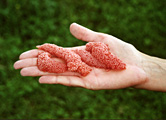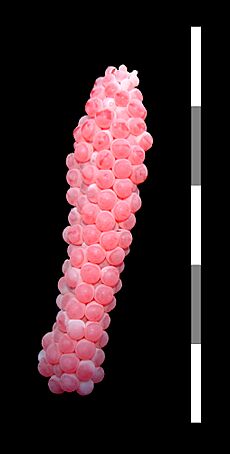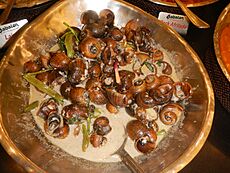Golden apple snail facts for kids
Quick facts for kids Golden apple snail |
|
|---|---|
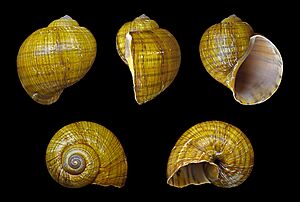 |
|
| Five views of a shell of Pomacea canaliculata, Shell diameter 8 cm (3+1⁄4 in) | |
| Conservation status | |
| Scientific classification | |
| Kingdom: | |
| Phylum: | |
| Class: | |
| (unranked): |
clade Caenogastropoda
informal group Architaenioglossa |
| Superfamily: |
Ampullarioidea
|
| Family: | |
| Genus: |
Pomacea
|
| Subgenus: |
Pomacea
|
| Species: |
P. canaliculata
|
| Binomial name | |
| Pomacea canaliculata (Lamarck, 1819)
|
|
The golden apple snail, also known as the channeled apple snail, is a large freshwater snail. Its scientific name is Pomacea canaliculata. It's a type of gastropod mollusc, which means it's a snail with a shell.
This snail has gills to breathe underwater and a special "trapdoor" called an operculum. This trapdoor helps it close off its shell. Golden apple snails belong to the family Ampullariidae, which are known as apple snails.
Originally from South America, this snail has become a big problem in many parts of the world. It's listed as one of the "World's Worst Invasive Alien Species". This means it spreads quickly and harms the environment where it doesn't naturally belong.
Contents
Where Golden Apple Snails Live
Golden apple snails are naturally found in warm, tropical, and subtropical areas. Their native home includes countries like Argentina, Bolivia, Paraguay, Uruguay, and Brazil. The southernmost place they are found naturally is in Argentina.
Where They Have Spread
These snails have spread to many other places around the world. In the United States, they likely arrived from people releasing them from aquariums. They are now found in states like Indiana, Alabama, Florida, California, and Hawaii.
Further north, the Government of Alberta in Canada has declared them an invasive species. Officials are working to stop their spread there.
Golden apple snails have also been found in China since 1981. They first appeared in Zhongshan city. They also reached Chile in 2009.
In the 1980s, these snails were brought to Southeast Asia as a food source and aquarium pets. They were introduced to places like Taiwan, Japan, Thailand, and the Philippines. However, many snails escaped or were released. They have since become a major problem for farmers.
Recently, in 2020, golden apple snails were found in Kenya. This was the first time they were seen in mainland Africa.
What Their Shells Look Like
The shells of golden apple snails are round, like a globe. They usually have stripes of brown, black, and yellowish-tan colors. However, their patterns can vary a lot.
You can also find snails with unusual colors, like albino (white) or gold shells. These snails can grow quite large. Their shells can be up to 150 millimetres (6 in) long.
How Golden Apple Snails Live
Their Habitat
These snails live in freshwater places like lakes, rivers, ponds, and swamps. They can handle many different temperatures. In their natural homes, they lay their eggs on grasses and other plants growing near the water's edge.
However, where they are invasive, they will lay their eggs on crops. This includes plants like rice and taro.
What They Eat
Golden apple snails eat many different things. They mostly eat plants, especially floating or underwater plants. They also eat dead plant and animal matter, and sometimes even small animals.
What they eat can change as they grow. Younger, smaller snails often eat algae and tiny bits of decaying matter. Older, larger snails (about 15 millimetres (19⁄32 in) or bigger) start eating larger plants.
Because they eat so many plants, they cause a lot of damage. They harm rice and taro farms around the world where they have spread.
Life Cycle and Reproduction
In places with changing seasons, these snails lay eggs from early spring to early fall. In tropical areas, they can lay eggs all year round. The time they spend laying eggs gets shorter the further away they are from the equator.
Adult female snails lay their eggs at night on plants that stick out of the water. They also lay eggs on rocks and man-made surfaces like boats. The eggs take about two weeks to hatch. When first laid, the eggs are a bright pink or orange color. This color fades as they get closer to hatching.
Predators
In South America, a bird called the snail kite (Rostrhamus sociabilis) eats these snails. The fire ant (Solenopsis geminata) has also been seen eating them.
Parasites
About 1% of the golden apple snails sold in markets in China were found to carry a harmful parasite. This parasite, called Angiostrongylus cantonensis, can make people sick if they eat raw or undercooked snails.
How to Control Them
Scientists are looking for ways to control these invasive snails. Some plant extracts, from plants like Oldenlandia affinis and Viola odorata, can kill the snails. These extracts work as well as some man-made snail poisons.
Another way to control them is by changing water levels in fields. If the developing eggs are kept underwater, fewer of them will hatch. This can help manage snail populations in farms and reservoirs.
How People Use Golden Apple Snails
Golden apple snails can be eaten by humans. They are one of the most common freshwater snails found in Chinese markets. However, eating them raw or undercooked can lead to serious illness from parasites.
In Thailand, people collect these snails by hand or with nets from canals and rice fields. During the dry season, they use spades to dig them out of the mud. Women and children often collect the snails.
After collecting, the snails are cleaned and partly cooked. Then, the meat is taken out of the shells and cleaned again with salt water. The snail meat is mixed with spices and eaten.
Some French restaurants have even tried using golden apple snails as an alternative to traditional escargot. They clean the snails carefully to remove any bad smell.
In some paddy fields in Japan, golden apple snails are used to control weeds. The snails eat the weeds, which helps the rice plants grow. However, there's a risk that the snails might also eat young rice plants. They can also spread to other fields and waterways, becoming a pest.
These snails are also sold as pets for freshwater aquariums.
See also
- Keong Emas
- Ovorubin
- Perivitellin-2



